Art & Painting.
July 19, 2020
Art and painting.
I like art in all its variations.
I like sculptures as well as paintings.
I like western art as well as eastern art.
I like traditional figurative art as well as non-figurative modern art.
Just as with music I have a wide and broad interest in all types and styles of painting and sculpture and art in general.
And I do have my own personal favorite artists.
As with musicians I admire numerous different painters from all periods in art history.
From early Flemish to Italian renaissance to French baroque and rococo painters, to British Pre-Raphaelites, to French impressionists, to German Blaue Reiter painters, to American action-painters and so on.
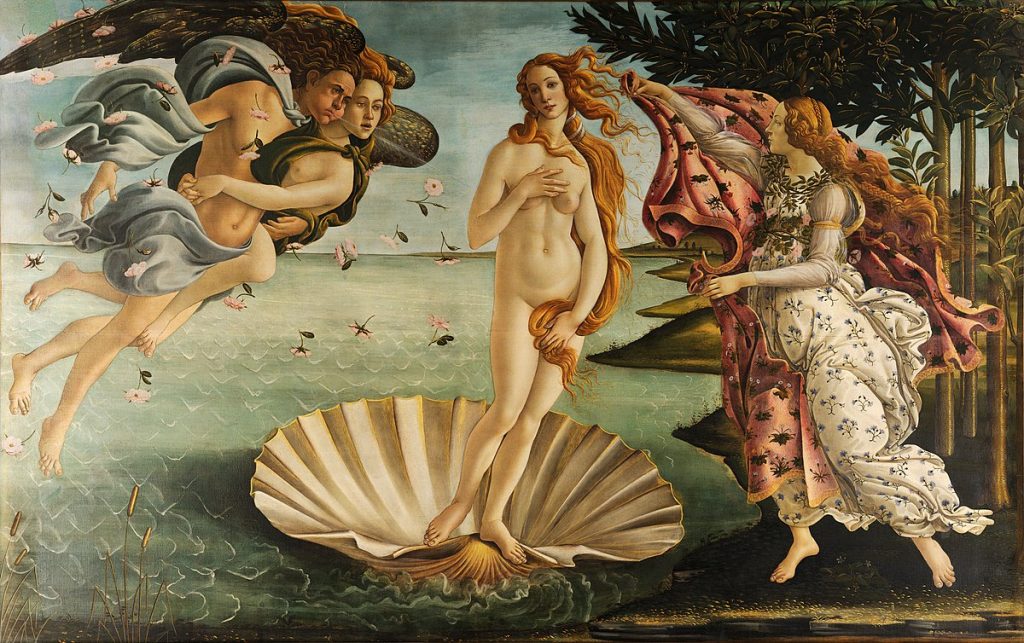
Painting by Italian Renaissance painter Sandro Botticelli (Real name: Alessandro di Mariano di Vanni Filipepi
c. 1445 – May 17, 1510) called the Birth of Venus.

Painting by early Flemish painter Jan van Eyck ( c. before 1390 – 9 July 1441)
The Arnolfini Portrait or The Arnolfini Wedding.

Painting by French Baroque painter Nicolas Lancret (22 January 1690 – 14 September 1743) Mademoiselle de Camargo dancing.

“Bower Meadow” painting by British painter Dante Gabriel Rosetti (12 May 1828 – 9 April 1882) , member of the Pre-Raphaelites.

Painting called “Madam de Pompadour” by French rococo painter Francois Boucher (29 September 1703 – 30 May 1770).

Painting called “Parc Monceau” by French impressionist painter Claude Monet (14 November 1840 – 5 December 1926)

Painting by Wassily Kandinsky ( 16 December [O.S. 4 December] 1866 – 13 December 1944) of Der Blaue Reiter group, expressionist painter: View of Murnau.

Painting by Franz Marc (February 8, 1880 – March 4, 1916), member of Der Blaue Reiter group, expressionist painter called Horses and Eagle.
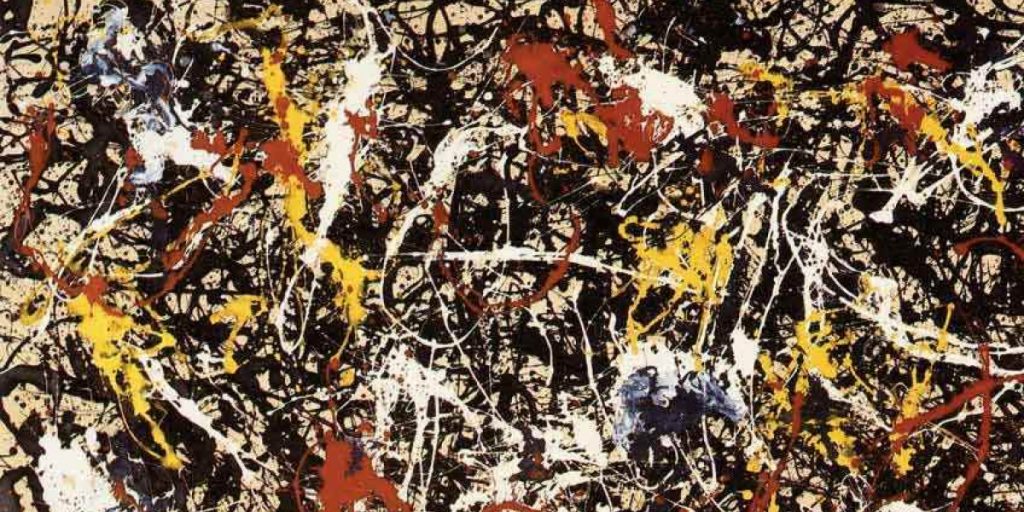
Painting by American action-painter Jackson Pollock (January 28, 1912 – August 11, 1956): Convergence.
In my early youth I learned to paint with oil-paint. I remember that I had to master the techniques. How to handle a painters stick. Work with palette knives. With all the different sorts of paint-brushes. Pigskin-hair brushes, marten-hair brushes, artificial filament brushes, thin paint-brushes, thick paint-brushes, fan-shaped paint-brushes, and so on. I had to master wet-in-wet painting techniques and layer-over-layer painting techniques. I had to learn about the materials and how to use them.
The different painting-mediums such as linseed-oil and poppy-oil, siccatives to shorten the drying time of oil-paint, using lead containing paints, covering colours, the effects of semi-transparent paints and transparent paints, different sorts of varnishes and a lot more.
I remember, at a certain instance I thought painting with oil-paint took too long. Always having to wait again and again till the layer was dry. Every time that took several days. And it didn’t get on. I admit, I was rather impatient. Then I changed to acrylic paint, because that dries almost immediately, ha,ha,ha. But using acrylic paint limits the possibilities. You can do less with acrylic paint than with oil-paint. So I guess one day I will be returning to using oil-paint again.
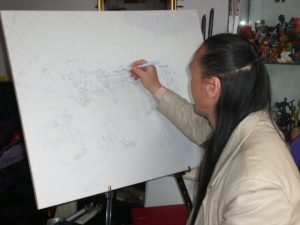

I was taught to draw and that the drawing should be the basis for the painting. So I sort of stuck to the illustrative and figurative painting. First set up a drawing and only then start painting. The composition must at first be in your mind as a sketch. The colours arise inside of me as I paint. Sheer process of creation. Creating something, like a song, like a poem, like a painting, it is all the same creative process! Painting “led by feelings or intuition” I never did. It’s not that I don’t like it but it’s just not my thing.
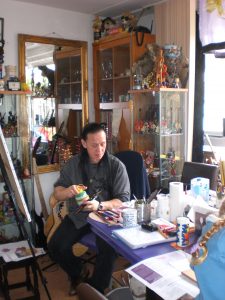
I must say that now I do think differently about art and specifically painting than I did when I was young. I learned that art is something which springs from within the artist. From the heart and soul. You can learn to master all the painting-techniques in the world and still not be an artist. You can learn to paint as good as the Italian Renaissance painters did or learn to copy a painting by Rembrandt. Then you’re a good and excellent craftsman. The mind can master the techniques or the theory but true art springs from a different well. I learned to appreciate painters who paint by intuition and instinct. Who use forms, colours and composition to create artworks that seem to spring from their inner well: human emotions.



I made a painting together with artist LaReinaWilleke for the parents of a 12-year old girl called Milly Boele from the city of Dordrecht in the Netherlands, who was murdered by a neighbour in 2010. That neigbour also happened to be a policeman. He was later sentenced to 18 years in prison and forced admission to a forensic psychiatric institution.
LaReinaWilleke paints intuitively and her drive comes from her inner emotions. She uses form, colours and composition to create her paintings. It’s totally different from what I do. She made the painting and left a space for me to paint the portrait. So I painted the portrait of young Milly in pastel-colours. I think it was a nice collaboration between two painters with totally different styles. The parents liked the painting.




Handing over the painting to the parents of Milly Boele in june 2010.

The parents of young murdered Milly Boele together with LaRainaWilleke and Ron Lindeman
But nevertheless, as for art is concerned, there are some side remarks I have to pose here. These are just my personal views on art and painting I ventilate here. Not more than that.
My views on art have indeed always been rather pragmatic. The problem with art and music is that it can easily get out of control if the philosophy becomes more important than the work of art itself. What do I mean by that? In the following story I will try to explain what I mean. These are my personal views!
Desire to change and renew.
A painting consists of the material on which you paint, the material wherewith you paint it, the composition, the colours, the subject, etc. But during the history of painting one sees that painters always wanted and still want to “renew” all, yet to always again change something in the existing perception of what was the art of painting. For example: the material on which you paint doesn’t matter anymore; the material wherewith you paint doesn’t matter anymore; the composition can be different; the colours can be different and so on.
The visible figurative concept disappears and the contours of people, animals and objects fade.
The once almost razor-sharp painted images changed into blurred images.
Compare a painting by Leonardo da Vinci (14/15 April 1452 – 2 May 1519) : Madonna and child or The Litta Madonna,

with a painting by Claude Monet (14 November 1840 – 5 December 1926): Portrait of Therese Berard,
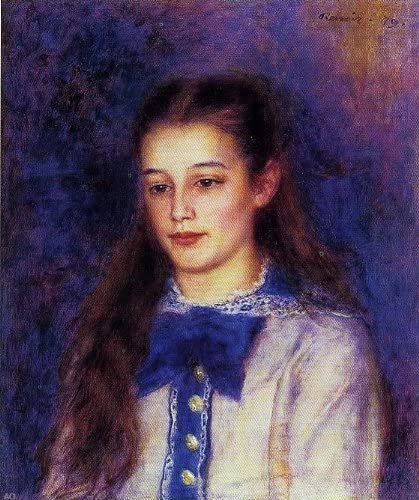
or Auguste Renoir (25 February 1841 – 3 December 1919): In the meadow.

You can actually see how the strictly and refined figurative paintings change into less refined details and sometimes hazy or blurry figures.
You can see how the use of dark colours and “natural “colours used by the Italian renaissance painters is changed into pastel colours by the French impressionist painters. The difference is even greater when the expressionist painters enter the scene. The dark, brown colours change into bright primary colours.
Just compare a painting by the Dutch painter George Hendrik Breitner (12 September 1857 – 5 June 1923) : Singel bridge near the Paleis street in Amsterdam,

with a painting by Dutch painter Vincent van Gogh (30 March 1853 – 29 July 1890): The artist on his way to work.

The use of colours changes drastically in the course of the history of western painting: from renaissance painters to impressionists; from impressionists to expressionists; from expressionists to abstract artists, etc.
From Italian Renaissance painter Sandro Botticelli (Real name: Alessandro di Mariano di Vanni Filipepi c. 1445 – May 17, 1510): The Spring,

to the English painter John Constable ( 11 June 1776 – 31 March 1837): Sunset in Westminster, London,

and the English painter Joseph Mallord William Turner (23 April 1775 – 19 December 1851): The Decline of the Carthaginian Empire,
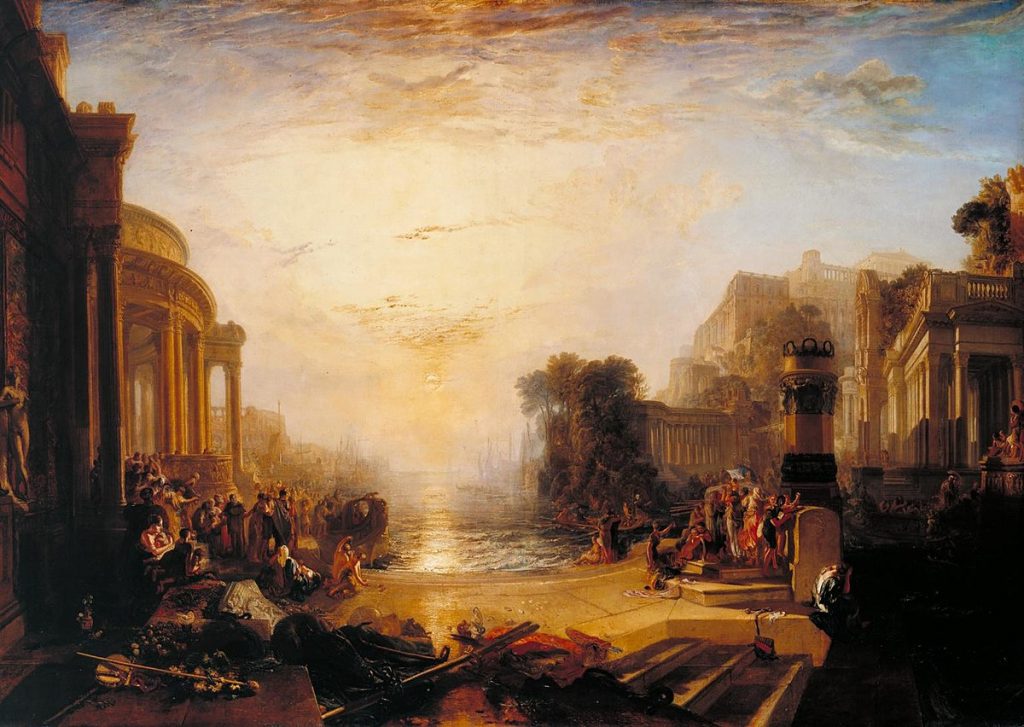
From Joseph Mallord William Turner (23 April 1775 – 19 December 1851): The burning of the Houses of Lords and Commons,

and Vincent van Gogh (30 March 1853 – 29 July 1890): Bedroom in Arles,

to Auguste Renoir (25 February 1841 – 3 December 1919): the daugthers of Durand-Ruel,

From Auguste Renoir: Woman playing guitar,

to the Spanish painter Pablo Picasso (25 October 1881 – 8 April 1973): Women of Algiers,

and the Spanish painter Joan Miró (20 April 1893 – 25 December 1983) : Catalan landscape.

From Joan Miró: Carnaval of Arlecchino,

to Swiss-born painter Paul Klee ( 18 December 1879 – 29 June 1940): Castle and sun,

and to Dutch painter Karel Appel (25 April 1921 – 3 May 2006): the Flower and the birds .

It are all just examples!
The different styles and techniques used in painting and the different groups of artists formed, increased drastically.
When it was accepted that one didn’t need to exactly and precisely “copy” human figures or one didn’t need to exactly copy a vase with flowers or didn’t need to copy animals precisely or landscapes or buildings or whatever precisely anymore, the road to artistic freedom and free use of material, colours and artistic concepts was open.
I mean, why paint a woman like she is?
It’s nicer to paint her with fading contours in nice soft pastel colours with touches of primary colours added.
Or use dots like the French pointillist painters such as George Seurat did.
Or paint a vase with sunflowers with thick brushes and lots of paint in thick layers making it look like a sort of bas-relief artwork and using bright primary colours like Van Gogh did.

“A Sunday afternoon on the Island of Grande Jatte” by French “pointillist” painter George Seurat (2 December 1859 – 29 March 1891)

Painting by Joseph Mallord William Turner: Goldau.

Painting by Joseph Mallord William Turner: Rain, steam and speed.

“Landscape Auvers-sur-Oise” by French impressionist painter Auguste Renoir
I can imagine how painters must have felt in those days in the late 19th century and early 20th century when a lot of changes took place. Maybe it also was because photography entered the scene and painters found that they didn’t need to “copy” anymore.
Photographers could do that!
So as a painter you could start painting in a different and more free fashion. And once the first obstacles were taken the search and urge and desire to “be different” must have inspired and ignited the minds and hearts of those painters. Painters who started using different techniques or change some of the standard academically determined rules and laws of painting soon got eager followers.
I can guess how some French painters must have felt when they saw the paintings of the British painter Joseph Mallord William Turner. His paintings of ships on the sea or trains disappearing in the smoke or hazy vague landscapes and the like were so different.
No distinctive shape and figures anymore and the deviating different colour-palette he used. It must have really impressed the French painters. Personally I like the French impressionists because I like pastel colours.But that’s just personal. I don’t use those colours myself so much but I really like them. The French painter Auguste Renoir is my favourite impressionist painter because of his colour-palette.
I mean, when a man like the Spanish painter Pablo Picasso started to introduce his concept of Cubism with strange looking figures and he and the French painter Georges Brauque started using other materials besides oil-paint to put on his canvasses it must have felt like the sky was the limit.

Pablo Picasso started using other materials besides paint. Like pieces of the paper from a newspaper. This painting is called: Bottle of Vieux Marc, Glass, Guitar and Newspaper, painted in 1913 by Pablo Picasso (1881-1973)

Painting by Georges Braques ( 13 May 1882 – 31 August 1963) : Still life on table ( formerly Gillette) 1914. Use of other materials such as cut and pasted newspaper..
I am not so much into art history, but I have always been very interested in the different art directions and groups.
Expressionism, impressionism, Pre-Raphaelites, Art nouveau, Avant Garde, surrealism, primitive art, cubism, Dada, Bauhaus, Cobra, action-painting, pop-art, conceptual art, digital art, etc, etc.
I can relate to most of them and what they did .
But that’s not my point.

“Tiger in tropical storm” by French naive or primitive painter Henri Rousseau (21 May 1844 – 2 September 1910).
Collage from paper cuts called “knife” from German Dada artist Hannah Hoch (1 November 1889 – 31 May 1978).

Cut with the Kitchen Knife through the Last Weimar Beer-Belly Cultural Epoch in Germany (Schnitt mit dem Küchenmesser durch die letzte Weimarer Bierbauchkulturepoche Deutschlands). 1919-1920
Photomontage and collage with watercolor, 44 7/8 x 35 7/16 (114 x 90 cm)
Staatliche Museen zu Berlin, Nationalgalerie
© 2006 Bildarchiv Preussischer Kulturbesitz, Berlin,
© 2006 Hannah Höch / Artists Rights Society (ARS), New York / VG Bild-Kunst, Bonn, photo: Jörg P. Anders, Berlin

Painting by Spanish surrealist painter Salvador Dali (11 May 1904 – 23 January 1989): Face and fruit dish.
Dali’s real name was Salvador Domingo Felipe Jacinto Dalí i Domènech, 1st Marquess of Dalí de Púbol.

“Les demoiselles” by Cubist painter Pablo Picasso

Pop-art painting by American painter Andy Warhol ( real name Andrew Warhola; August 6, 1928 – February 22, 1987) called “Marilyn”.
Everything went on and on and on and on and there seemed to be no stop to it.
But at a certain instance there was just nothing left to change anymore.
You change the way you think about painting figuratively, you change the way you use the colours, you change the way you use the brushes and types of paint and mediums, you change the materials you paint on, you add new materials next to different types of paint, you start slinging or throwing the paint onto the canvas instead of using brushes, and at a certain instance it must stop.
Because there is simply nothing more to change .
But then artists started making the philosophy of art more important than the art itself. And then artists started to get crazy ideas about art. At least, that is my modest opinion. An artist picks up a piece of wood and declares that it is now art and calls it “objet trouvé ” ( found object) .
Here’s a description of the concept of Objet Trouvé or Found Object.
Objet trouvé art
A French term for a natural or discarded object found by chance and held to have some aesthetic value to an artist. Artists have always used various materials and some have made a virtue out of creating impactful art out of found objects. In singular, these are called objet trouvé and in plural Objets trouvés.
It relates directly to Marcel Duchamp’s readymades, Dada and Fluxus art.
Art critics have coined the terms arte povera (Italian) and junk art (Anglo-American) to signify art which incorporates the said objects.
As a more recent development, artists can enter so-called ‘Trashion’.It is the use of trash to create art and fashion. Many organisations sponsor junk art competitions like these. In addition, Trash art may has a social purpose, of raising awareness about trash and conspicuous consumption combined with depletion of natural resources.
( From the website Xamou)
Below an example of a bicycle wheel which was promoted to become an art object by French painter/artist Marcel Duchamp (28 July 1887 – 2 October 1968) in 1913.

“Readymades” were found objects which French painter /artist Marcel Duchamp (28 July 1887 – 2 October 1968) chose and presented as art. In 1913, Duchamp installed a Bicycle Wheel in his studio. However, the idea of Readymades did not fully develop until 1915. The idea was to question the very notion of Art, and the adoration of art, which Duchamp found “unnecessary”.
My idea was to choose an object that wouldn’t attract me, either by its beauty or by its ugliness. To find a point of indifference in my looking at it, you see.
The philosophy behind the art has slowly started to become more important than the art itself.
I question that. Is it good, is it bad?
I have my doubts.
I mean changing concepts and changing ideas can be good sometimes to renew or freshen up old fixed and stuck ideas and concepts. It’s always good to broaden your spiritual and mental horizon. But then the new ideas and concepts must make some sense!
Otherwise it is not “the sky is the limit” anymore. It then has become more of: “we’re totally lost in outer space”. It becomes silly, ridiculous. If not to say stupid. But that is my personal opinion.
Recognizabillity.
Of some painters you will recognize their specific signature.
The “touch”, thus the way in which they use the paint-brushes.

The Dutch painter Frans Hals the Elder (c. 1582 – 26 August 1666): Gypsy girl,

and the Dutch painter Rembrandt Harmenszoon van Rijn (15 July 1606 – 4 October 1669) had a recognizable paintbrush wielding. Rembrandt van Rijn: Self-portrait.
So did Vincent van Gogh. You recognize it.
It’s a painting by Frans Hals, it’s a painting by Rembrandt, it’s a painting by Van Gogh.

Sunflowers by Vincent van Gogh.
The use of light.
Rembrandt used the light in his paintings in his own way. I think his use of light is fantastic. But his contemporaries didn’t think so at all. The clients who commissioned him to paint the painting nowadays referred to as “the Nightwatch” found it a terrible painting. The use of light in the painting was totally wrong as some of the figures were hardly seen and recognized while others were partly in bright light.
I think it is fantastic but it also shows that people don’t always recognize beauty in art. People are often blinded by what they consider to be the ruling laws of what art must be. And they don’t realize that in essence there is no such thing.
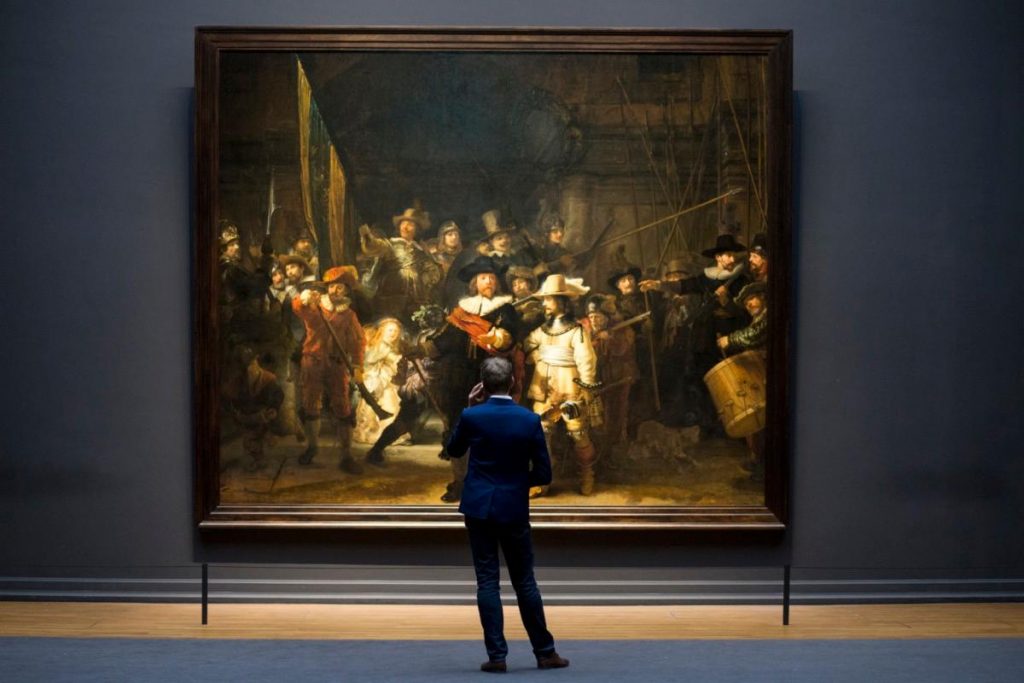








The Nightwatch by Rembrandt van Rijn and it’s restoration in 2019.
Militia Company of District II under the Command of Captain Frans Banninck Cocq, also known as The Shooting Company of Frans Banning Cocq and Willem van Ruytenburch, but commonly referred to as The Night Watch (In Dutch it is called De Nachtwacht), is a 1642 painting by Rembrant van Rijn.
There’s also a kind of hypocrisy. I mean, Rembrandt died a poor man. And only after his death the Dutch made him an icon in Dutch and world art history. When he was alive they considered him to be a bad painter. That’s hypocrite. Or what to say about Vincent van Gogh. He never sold a painting during his life. People judged him to be a bad painter. He made silly drawings and silly paintings and he was crazy. Van Gogh never had an official education. Two times he spent some time in the atelier of a painter, once in The Hague in The Netherlands and once in Paris in France. When he was alive nobody took Van Gogh serious. And maybe a century later the Dutch built a special museum: the Van Gogh museum. They should have built him a museum when he was alive instead of considering him to be a lunatic when he was alive. It’s hypocrite. He died totally poor and a century or so later Japanese and Australian and other businessmen paid tens of millions of dollars for his paintings.

Wheatfield with crows by Vincent van Gogh
The use of colours.
Vincent van Gogh used colours that are recognizable.
So did Auguste Renoir.
There are many painters who are recognizable by their specific colour-palette.
Like Austrian symbolist painter Gustav Klimt (July 14, 1862 – February 6, 1918) using gold paint.

Gustav Klimt (July 14, 1862 – February 6, 1918):The Kiss
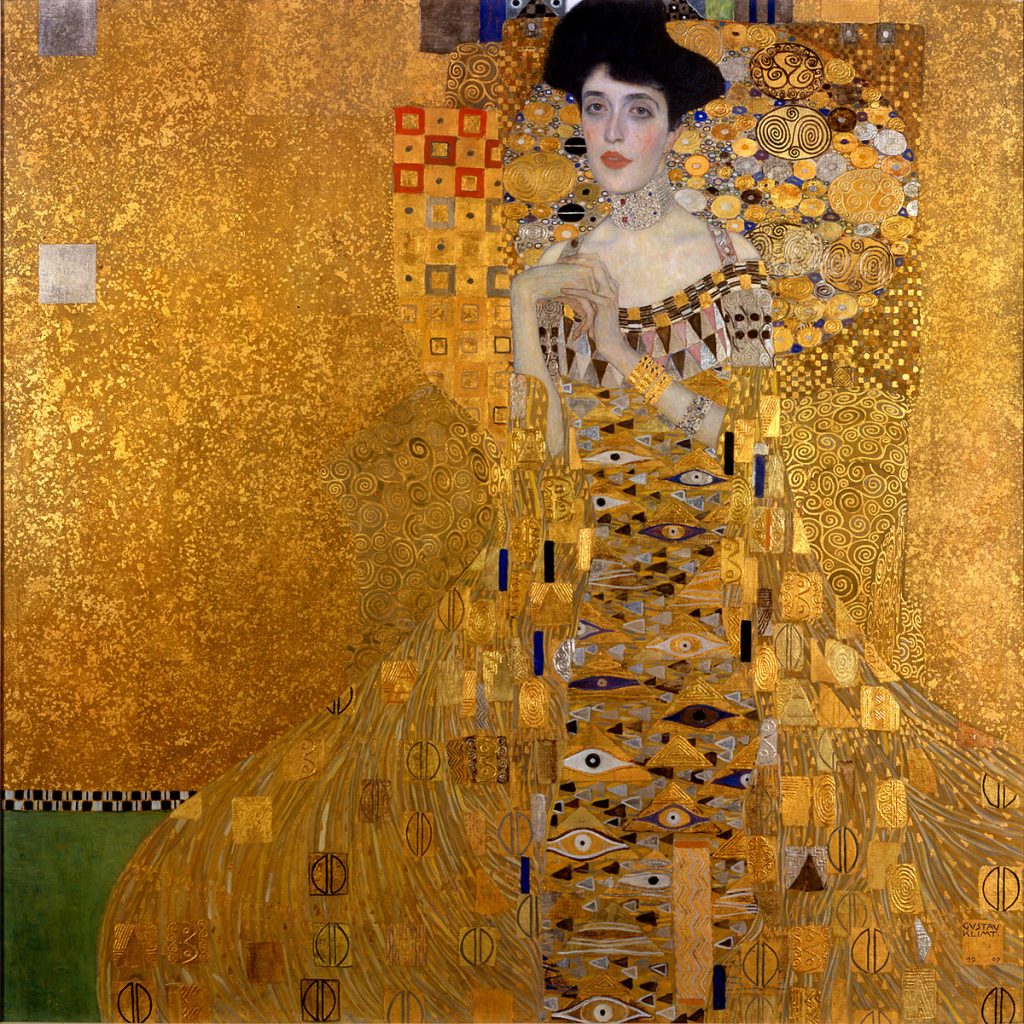
Gustav Klimt Portrait of Adele Bloch-Bauer

Vincent van Gogh The Sower

Auguste Renoir Young girl with long hair in profile
The dynamics within the painting.
A painting by Van Gogh is bursting with dynamics
The strokes almost move on the canvas when you look at it.
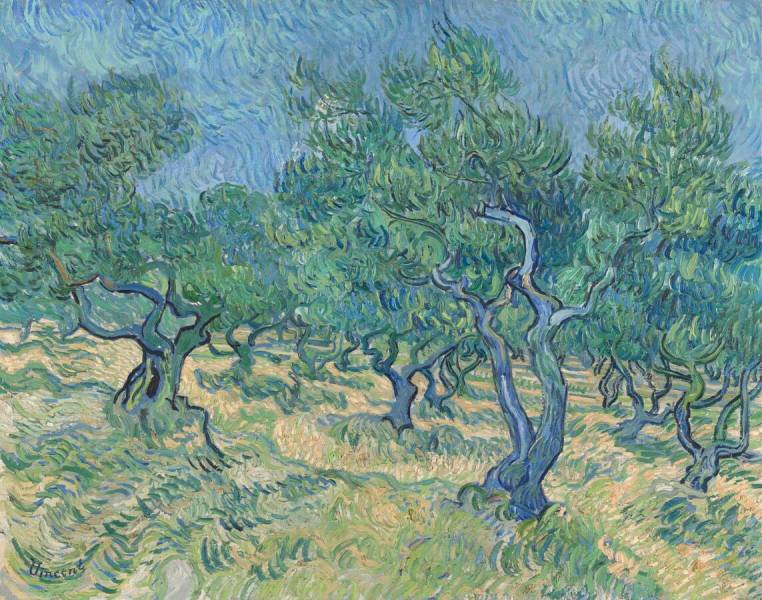
Vincent van Gogh Olive grove

Vincent van Gogh The Mulberry tree in autumn
I love paintings by Van Gogh. I love to experience the movement when you stand in front of one of his paintings. Everything in the painting seems to move. When you’re in Amsterdam, visit the Van Gogh museum!

Nothing more to change!
But what if there is simply nothing left anymore to change?
Then at a certain instance only the thought behind the artwork becomes important.
The philosophy of the artwork becomes more important than the artwork itself.
For example:
An artist finds a piece of wood out on the street and calls that: “Objet trouvé” or “Found Object”.
Only and alone because he is an artist and he names an ordinary piece of wood “Found Object”, that piece of wood suddenly is elevated to the status of “artwork”.
Nowadays there are more modern approaches to the Objet Trouvé idea.

Dutch artist Karel von Kleist ( born 1951): Objet Trouvé
acrylic & objects (plastic, stone, metal, plaster) on canvas
49 cm X 64 cm
July 2005
For example:
Somewhere in the sixties there was an Italian artist Piero Manzoni ( 1933- 1963), who canned his shit and exhibited it as “Merda d’artista” ( Shit from the artist).
“Shit from the artist” thus!
It’s really true.
It really happened!

Italian artist Piero Manzoni ( 1933- 1963) became famous because he put his own feces in tin cans.
Piero Manzoni was an Italian Conceptual artist best known for his shocking pieces that questioned the nature of art objects. In perhaps his most provocative work, Merda d’artista (Artist’s shit) (1961), the artist filled and sealed 90, 30-gram tin cans, with his own feces. “I should like all artists to sell their fingerprints, or else stage competitions to see who can draw the longest line or sell their shit in tins,” Manzoni wrote. “If collectors really want something intimate, really personal to the artist, there’s the artist’s own shit. That is really his.”


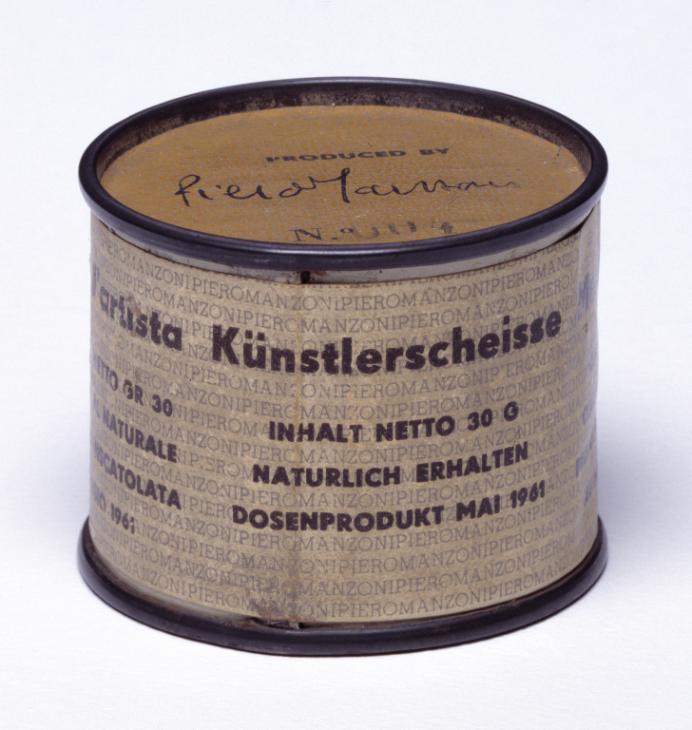
For example:
The Dutch female artist Marte Röling ( whom I greatly admire!) had a partner Henk Jürriaans, who some decades ago in the seventies of the previous centrury stood in the Stedelijk Museum in Amsterdam.
As a living artwork.
I may be a simple soul but this is way above my head.
And I don’t mean to be offensive.
 Dutch painter Marthe Röling (born 1939-) had a partner called Henk Jurriaans (1940-2005). Henk Jurriaans was a psychologist and psychotherapist who became known when in the seventies ( 1975) he exhibited himself as a living work of art in the Stedelijk Museum for Modern Art in Amsterdam in The Netherlands. For 25 days he stood in the Stedelijk Museum for one hour per day and the Stedelijk Museum for Modern Art paid him 2500 Dutch guilders ( the old currency in The Netherlands) for doing that. ( At the time there were no euros)
Dutch painter Marthe Röling (born 1939-) had a partner called Henk Jurriaans (1940-2005). Henk Jurriaans was a psychologist and psychotherapist who became known when in the seventies ( 1975) he exhibited himself as a living work of art in the Stedelijk Museum for Modern Art in Amsterdam in The Netherlands. For 25 days he stood in the Stedelijk Museum for one hour per day and the Stedelijk Museum for Modern Art paid him 2500 Dutch guilders ( the old currency in The Netherlands) for doing that. ( At the time there were no euros)


Henk Jurriaans exhibited as a living work of art in 1975 in the Stedelijk Museum for Modern Art in Amsterdam.
It are just a couple of examples of how things can easily be lost in intellectual vagueness and mental fuzziness .
The Bulgarian artist Christo (Christo Vladimirov Javacheff, 1935 – 2020), wrapped, among others, the Reichstag building in Berlin, Germany and the Pont-Neuf bridge in Paris, France. He called it environmental artworks. He claimed that what he did was art and he did it solely because of the aesthetics of his artworks and not to give his works a deeper underlying meaning. He said it was to make people see landscapes in a different way. It took him 24 years of talks, negotiations and preparations, a gigantic amount of polypropylene fabric, kilometers of rope, and after the building was wrapped, it stood there like that for two weeks. The wrapping began on June 17, 1995, and was completed on June 24 1995.

Christo about the wrapping of the Reichstag building:
“1,076,390 square feet (100,000 square meters) of thick woven polypropylene fabric with an aluminum surface and 9.7 miles (15.6 kilometers) of blue polypropylene rope, diameter 1.26 inch (3.2 centimeters), were used for the wrapping of the Reichstag. The façades, the towers and the roof were covered by 70 tailor-made fabric panels, twice as much fabric as the surface of the building.
The work of art was entirely financed by the artists, as in all previous projects, through the sale of preparatory studies, drawings, collages, scale models as well as early works and original lithographs. The artists do not accept sponsorship of any kind.
The Wrapped Reichstag represents not only 24 years of efforts in the lives of the artists but also years of team work by its leading members Michael S. Cullen, Wolfgang and Sylvia Volz, and Roland Specker.
The Reichstag stands up in an open, strangely metaphysical area. The building has experienced its own continuous changes and perturbations: built in 1894, burned in 1933, almost destroyed in 1945, it was restored in the sixties, but the Reichstag always remained the symbol of Democracy.
Throughout the history of art, the use of fabric has been a fascination for artists. From the most ancient times to the present, fabric forming folds, pleats and draperies is a significant part of paintings, frescoes, reliefs and sculptures made of wood, stone and bronze. The use of fabric on the Reichstag follows the classical tradition. Fabric, like clothing or skin, is fragile; it translates the unique quality of impermanence.
For a period of two weeks, the richness of the silvery fabric, shaped by the blue ropes, created a sumptuous flow of vertical folds highlighting the features and proportions of the imposing structure, revealing the essence of the Reichstag.”


Now you can question yourself whether it is the summum of how the philosophy of art has become more important than the work of art itself, or you can consider it to be a genuine work of art. To actually do such things factually costs a fortune, just the materials alone perhaps cost tens of thousands of dollars or maybe even a lot more than that, a real fortune and the artwork itself doesn’t last very long. Weather influences destroy it and it’s practically inconvenient to have a big building wrapped. You can’t open the windows and doors don’t really open and close anymore. And if you can open them it useless. So it’s not very functional. The aesthetics are questionable. I mean, not everyone would like to look at a big building wrapped and say: “Oh how beautiful!”
I reckon most people would say it’s stupid and crazy and a waste of money. For the tens of thousands of dollars or more it costs to do such a thing you could save the lives of thousands of hungry children in Africa. So, is it art or just a crazy idea of someone who likes to be in the spotlights? Something like: “Huh, look at me: I wrap a building”.
I mean, if I were to dress up my grandmother as a Christmas tree and hang her upside down from the Eiffel tower in Paris, France, the police would most likely arrest me and the judge would send me to prison for molesting my grandmother. I would probably be sent to a mental institution. So clearly it’s really who you are what seems to determine how far you can go.

Wrapping of the Reichstag building in Berlin, Germany by Christo.
Christo said the reason he wrapped the building was because of aesthetical reasons.
He said it looked beautiful.
Well that’s open to discussion.
I mean: if you say the Mona Lisa is beautiful, I agree.
That it costs a lot is not open to discussion.
That it is not very functional is not open to discussion.
That it won’t last too long is not open to discussion.
But its it art?
What do you think???? Is this art or lunacy?
I think that it’s more an intellectual idea, an intellectual concept.
But like I said: if I were to hang my grandmother upside down from the Eiffel-tower and wrap her up in a shiny piece of paper, I bet I get arrested!


Christo: wrapping of the Pont Neuf bridge in Paris. In September 1985, they wrapped the bridge and its 44 streetlamps in a sandstone-colored fabric. The two-week installation attracted three million visitors.
The 120,000 dollar duct-taped banana on the wall.

In 2019 an art gallery in Miami called Perrotin sold an artwork which was an ordinary banana taped with duct tape to the wall of the art gallery.
The “work of art” became world famous as people started to make all sorts of funny jokes and video’s about it on social media.
The banana duct-taped to the wall sold for 120,000 dollars ( !) and it was one of 3 similar “artworks”.
According to the gallery owner two of these “artwoks” had already been sold and the third was expected to be sold for at least 150,000 dollar.
The “artwork” was made by an Italian artist called Maurizio Cattelan, who named the banana duct-taped to the wall ” The Comedian”.
That seems to be an appropiate name for it!
The artist Maurizio Cattelan informed the buyers that they may replace the banana if they wanted!
A banana will be rotten in perhaps one or two weeks time.
Maurizio Cattelan, is also famous for another one of his works, an 18-karat gold toilet titled “America” valued at 6 million dollars that was later stolen from Blenheim Palace in England.
The owner and founder Emmanuel Perrotin of the art Gallery Perrotin, the gallery where the work was displayed, said that the “artwork” is “about how the meaning and importance of objects changes depending on the context”.

Now if you think this is funny; during the exhibition of the banana duct-taped to the wall, a performance artist called David Datuna from New York took the banana from the wall and he ate the “artwork”, which had sold for 120,000 dollars at Art Basel Miami!
Now, that’s funny!
He ate the banana in front of many art lovers who were watching the “artwork”.
A video of him eating the 120,000 dollar banana “artwork” appeared on video on social media afterwards.
Now David Datuna commented about this:
“I call the performance, ‘Hungry Artist,’ because I was hungry and I just ate it”.
He also said. “The banana tasted good. It tasted like 120,000 dollar. It’s not vandalism. I’m a performance artist, and this is my performance.”
Gallery owner Emmanuel Perrotin reacted by saying that he was “absolutely not pursuing any legal action,” and “never had any plans to from the very beginning.”
Now You can be flabbergasted about this the way I am or you can think that this may be some art scam which was invented by a clever gallery owner and a willing artist and others.
I don’t know, but that it is utterly ridiculous is certain!
And it worries me that there are people willing to pay 120,000 dollar for a banana duct-taped to the wall.
It gives me the feeling that all these people have lost all sense of reality.
But if this whole thing is real and not some invented art scam, than this must be even weirder than the shit-of-the-artist-in-a-can by Piero Manzoni.
What will be next?
Eat the banana and then wait untill you poop it out and then put the shit in a can?
This has nothing to do with art anymore.
It are gimmicks to get people’s attention.
And the succeeded in doing that!
It was coverered worldwide by the media.
The subjectivity of art

So the question rises: what is art?The answer is not easy. Art is subjective and subject to the perception of individual people.
What one considers to be beautiful is ugly to another. Art is subject to the personal taste of people. Art history hasn’t made it easier too. Art historians placed artists in different boxes, neatly organized and tagged.
Ah, you’re an Italian Renaissance artist, and you are a member of the Pre-Raphaelites, and you an Impressionist, and you are an Expressionist, and you are a Cubist and you a Fauvist and you an Action-painter and you a member of the Cobra and you a member of Der Blauer Reiter and you a member of Das Bauhaus and you are a member of Dada and you are a Surrealist and you do Pop-art and you, oh what are you????? All the different styles, groups, directions, scenes, etc. If the art historian hasn’t put you in one of the boxes, you can’t really be an artist!

“Bacchus and Ariadne” painted in 1523 by Italian Renaissance painter Titian. Tiziano Vecelli or Vecellio ( c. 1488/90 – 27 August 1576), known in English as Titian.

Painting by the Spanish Baroque painter Diego Velázquez: “Venus with mirror”. Diego Rodríguez de Silva y Velázquez (baptized June 6, 1599 – August 6, 1660) was a Spanish painter, the leading artist in the court of King Philip IV and of the Spanish Golden Age. He was an individualistic artist of the contemporary Baroque period.

Painting by the French painter Jacques-Louis David. Jacques-Louis David ( 30 August 1748 – 29 December 1825) was a French painter in the Neoclassical style

Painting by the English painter Thomas Gainsborough. Thomas Gainsborough (14 May 1727 (baptised) – 2 August 1788) was an English portrait and landscape painter.

“Insula Dulcamara” by “Bauhaus” painter Paul Klee. Paul Klee ( 18 December 1879 – 29 June 1940) was a Swiss-born artist. His highly individual style was influenced by movements in art that included Expressionism, Cubism, and Surrealism. He and his colleague, Russian painter Wassily Kandinsky, both taught at the Bauhaus school of art, design and architecture in Germany.

“Excavation” by Dutch abstract painter Willem de Kooning. Willem de Kooning (April 24, 1904 – March 19, 1997) was a Dutch-American abstract expressionist artist. He was born in Rotterdam and moved to the United States in 1926, becoming an American citizen in 1962.

“Women, Children, Animals” by Dutch “Cobra” painter Karel Appel. Christiaan Karel Appel ( 25 April 1921 – 3 May 2006) was a Dutch painter, sculptor, and poet. He started painting at the age of fourteen and studied at the Rijksakademie in Amsterdam in the 1940s. He was one of the founders of the avant-garde movement Cobra in 1948.

0333329
Piet Mondriaan
Title: Composition with Large Red Plane, Yellow, Black, Gray and Blue Painting
“Composition” by Piet Mondriaan. Pieter Cornelis Mondriaan, after 1906 Piet Mondrian (7 March 1872 – 1 February 1944), was a Dutch painter and theoretician who is regarded as one of the greatest artists of the 20th century. He is known for being one of the pioneers of 20th-century abstract art, as he changed his artistic direction from figurative painting to an increasingly abstract style, until he reached a point where his artistic vocabulary was reduced to simple geometric elements.
So what if you like figurative paintings by Titian, Rembrandt, Velasquez, Gainsborough, or David to name a few, can you then also appreciate paintings by non-figurative painters like Paul Klee, Willem de Kooning, Karel Appel or Piet Mondriaan to name a few examples?
Personally I think it’s possible.
The latter paint non-figurative, modern, abstract or however you might call it.
But did all of them produce “art”?
Size doesn’t really matter.
The Nightwatch by Rembrandt is a gigantic painting and so is the Guernica by Pablo Picasso but the Mona Lisa isn’t a really big sized painting.
It’s relatively small.
But they are both beautiful paintings.
At least that’s my personal opinion.


“Guernica” by the Spanish painter Pablo Picasso. It’s painted in 1937 from April 26th, 1937 till June 4th, 1937. Probably Picasso’s most famous work, Guernica is certainly the his most powerful political statement, painted as an immediate reaction to the Nazi’s devastating casual bombing practice on the Basque town of Guernica during Spanish Civil War in april 1937. Guernica is in black and white because it is digging into the truth behind pictures. A picture, in colours, is to be looked at. Picasso in Guernica does not want us to passively look, but to imagine this terrible moment from the inside. Colours let us off lightly; black and white forces us to think.
The scene occurs within a room where, on the left, a wide-eyed bull stands over a grieving woman holding a dead child in her arms. In the center of the room a horse falls in agony with a large gaping hole in its side, as if it had just been run through by a spear or javelin. The horse appears to be wearing chain mail armor, decorated with vertical tally marks arranged in rows.
The composition: A dead and dismembered soldier lies under the horse. The hand of his severed right arm grasps a shattered sword, from which a flower grows. The open palm of the soldier’s left hand contains a stigma, a symbol of martyrdom derived from the stigmata of Christ. A bare light bulb in the shape of an eye blazes over the suffering horse’s head.
To the horse’s upper right a frightened female figure appears to have floated into the room through a window, and witnesses the scene. She carries a flame-lit lamp, and holds it near the bare bulb. From the right, below the floating figure, an awe-struck woman staggers towards the center, looking into the blazing light bulb with a blank stare.
Daggers that suggest screaming have replaced the tongues of the horse, the bull, and the grieving woman. A dove is scribed on the wall behind the bull, part of its body comprising a crack in the wall through which bright light from the outside shines.
On the far right another woman, her arms raised in terror, is entrapped by fire from above and below. Her right hand suggests the shape of an airplane. A dark wall with an open door defines the right side of the room. (Description source: Wikipedia)
The technique might matter.
Painters like Titian and Johannes Vermeer and the French painters Watteau or David for example were specifically fine-painters who could really handle their brushes and knew how to apply and use the paints they used.

Titian, “Rape of Europa,” 1560-2.

Painting by Dutch painter Johannes Vermeer. Johannes Vermeer (October 1632 – December 1675), in original Dutch Jan Vermeer van Delft, was a Dutch Baroque Period painter who specialized in domestic interior scenes of middle class life.

Painting by French painter Jean-Antoine Watteau. Jean-Antoine Watteau (baptised October 10, 1684 – died July 18, 1721) commonly referred to as Antoine Watteau, was a French painter

Jacques-Louis David: “The coronation of Napoleon”.
So in the case of fine-painters one could say that technique matters.
You have to be able to carefully wield the brush using a painter’s stick.
You have to have a steady hand and a lot of patience because it takes time.
You have to really know the effects of the different sorts of oil-paint.
You have to know the results you get using different types of mediums.
You have to know the effects of the colours, transparent, semi-transparent or covering.

You have to know how you can build up a painting starting with a sketch and then applying dark colours to emphasize the shadows and let it dry and then work layer for layer applying lighter colours.
It’s a matter of know-how mixed with sheer experience that forms the master-painter and gives him his own recognizable style after years.
It’s like the cook creating his famous recipes to be able to make gourmets enjoy his dishes.
The cook will never reveal his true secrets.
The master-painter forms his own “recipes” in the course of his career which makes him able to create recognizable artworks.
You then will recognize his hand, style, touch, signature.
So you can admire that.
Nevertheless to develop a fabulous painting-technique doesn’t inherently mean that one makes aesthetically beautiful paintings.
It takes something else to do that.
You can paint a woman and call it Donna Lisa or you can paint a woman and call it Mona Lisa.
The first could be an average painting and the latter could become world-famous for its refined appearance and beauty.
Leonardo Da Vinci had such indefinable qualities which made him rise high above the average painter.
Like the exquisite cook.
There are cooks and cooks and there are painters and painters.
You can paint a horse or a cow or a nude woman or a farm or a vase of flowers.
It must contain some hidden other quality which makes it much more than just again another painting of a horse, cow, naked woman, farm or bunch of flowers in a vase.
That certain hidden quality is what art is about.


“Mona Lisa” by Leonardo da Vinci (14/15 April 1452 – 2 May 1519).
But what to say about modern abstract painters?
Mondriaan used geometric forms like rectangles, triangles, squares, etc and black and white and primary colours red, blue and yellow.
He used pieces of plastic and paper, oil-paint and chalk on his paintings.
Karel Appel just slung the paint from a distance upon the canvas straight from pots and tubes.
Jackson Pollock did something similar.
There is no refined painting technique with brushes and extensive knowledge of how paints, mediums or colours work .




Dutch painter Karel Appel in action.



Action -painter Jackson Pollock AKA Jack the Dripper in action
So what is art and what are works of art?
The paintings of Vermeer, Rembrandt or Titian are by most people considered to be true works of art.
They appeal to people.
But works by Karel Appel or Piet Mondriaan are often questioned to be real works of art.
Some people say: anybody could take a tube of paint and throw paint on a canvas!

Victory-Boogie by Piet Mondriaan.
Oil-paint, pieces of paper, plastic and black chalk are used.
It was actually never finished.
The Dutch state bought it for 80 million dollars using people’s tax-money
which caused public commotion and agitation in the Netherlands.
People didn’t understand why the state had to buy a painting
which wasn’t finished and most people didn’t even like, with
the people’s money. The state argued that it was an important
piece of Dutch cultural history.
In the museum for modern art in Amsterdam, the Stedelijk museum, hung a large painting in red and blue and yellow. It’s painted by an American painter called Barnett Newman (January 29, 1905 – July 4, 1970).
Maybe it stills hangs there.
It was large, meters wide and high and rectangular.
One day in 1986 an unknown Dutch painter named Gerard Jan van Bladeren put a Stanley-knife in the painting and slashed it from side to side.
So the guy was arrested and later sentenced to an 8 month sentence and a 6 month prohibition to visit the museum.
The museum hired an American restorer of paintings from New York called Daniel Goldreyer, who was to be paid a couple of hundreds of thousands of dollars or so to restore it.
The artist who made it claimed that he made the painting with a brush using oil-paint and applying red and blue and yellow dot by dot onto the canvas.
Judging by the size of it, it must have taken him years I guess, but who am I?
Now the restorer was accused to have simply used a paint roller instead of restoring it dot by dot with a brush and using acrylic house-paint instead of oil-paint.
The official forensic crime laboratory of the Dutch police and justice department was asked to check if the accusations were true.
So they found that the accusations were true and that the restorer had been lying: he had used a paint-roller and acrylic house-paint .
The museum refused to pay the money and both the restorer as well as the museum filed damages suits against each other.
More than 10 years later in 1997 the law suits were settled and the restorer was paid a a couple of hundreds of thousands dollars or so.
It caused a public row.
The guy who slashed the painting walked unnoticed into the Stedelijk museum, some months after he was released, and slashed another painting made by Bernett Newman.
Altogether a very weird but nevertheless very true story!
But you could question yourself why a really gigantic meters long and high rectangular canvas in plain simple red and blue and yellow was considered to be art in the first place and must have been purchased by the museum for an enormous amount of money from an artist who claimed he “painted “ the thing “dot by dot”, as if that would be an enormous artistic achievement and an enlightenment to art history and humankind!
And why the hell they bothered to pay a “restorer” another huge sum of money to “restore” it with a simple paint roller.
And pay hundreds of thousands of dollars for that!
That’s plainly incredibly crazy.



“Who’s afraid of Red, Blue and Yellow III” was “attacked” in 1986 by a 33 year old Dutch painter who slashed it with a Stanley-knife. Measuring 224 by 544 cm, this 1967 painting is part of the collection of the Stedelijk Museum in Amsterdam. It was attacked with a knife by Gerard Jan van Bladeren in 1986 and restored by Daniel Goldreyer in 1991. The restoration initially cost some $400,000, but was heavily attacked by critics who claimed that subtle nuances in the three monochrome sections had been lost and that Goldreyer had used house paints and a roller. According to critics, the painting had been destroyed twice: first during the attack, and again during the restoration. Goldreyer filed a $125 million suit against the City of Amsterdam and the Museum, claiming that his reputation was damaged. After lawsuits, settlements, and further restoration, the final cost of the attack was estimated to be close to $1 million. The Amsterdam city council asked for a full forensic report on the controversial restoration. When the report was finished, the City of Amsterdam and Goldreyer agreed to keep it under wraps, as part of a settlement. But almost 20 years later, on 11 September 2013, the Raad van State decided the report had to be made public by the Government of Amsterdam within six weeks. A week later the Volkskrant newspaper published the report’s main conclusions. It confirmed that Goldreyer had indeed repainted the entire red section with acrylic paint and had used a roller to add two layers of varnish to the, initially unvarnished, painting. According to the newspaper, Goldreyer’s restoration has “forever destroyed” Newman’s work. The painting was put on display again in the Stedelijk Museum in 2014.
The concept of beauty.
Is this what art is all about nowadays or should we just get rid of these ridiculous notions that the philosophy of art should be more important than the art itself and that moreover the philosophy of art, the idea behind the artwork, the concept, the thought, has nowadays become the artwork itself?
Why not go back to the simple notion and concept of “beauty”?
It’s like watching a soccer game on the field being played by two teams.
There are 22 men running around after a ball and between them there is one player who attracts attention.
Not because he runs so fast or kicks the ball so hard.
No, it’s just because of the way he moves and handles the ball, it’s the way he appears so graciously among the other players who, compared to him, look like fat immobile cows.
It’s an unexplainable quality, a certain “click”, a certain feeling of “wow” that spectators get when observing this one specific player on the field.
He stands out among all the others.
He’s the one drawing everyone’s attention.
Art should be like that.
Music as well should be like that.
When you watch an artwork or hear some music-piece and get that “wow-feeling” arising from within, from your heart and soul.
It’s the “click” you get.
Maybe art should be like that.
The relevance to music
In music the same happened.
Always wanting to renew till there is nothing anymore to renew and the philosophy becomes more important than the art of the music.

A different scale by Alban Berg
Monotonous repeating music in the minimalistic music. Here an unclear grasp at the snares, then a “ploiink-like-sound” from the double-bass, then a loud blare from a brass wind-instrument that scares the hell out of you, then again a total blaring cacophony of all sorts of instruments mixed up, then again dead silence, and all this together then also counts as a renewal in music.
I describe it all a bit simplistic perhaps but the idea is that the urge to renew and become one of the “renewers” on the frontline of art or music and become a historical figure in art history, may sadly dominate their minds.
Here are some examples of composers who wanted nothing else but renew the concept of music.

Philip Glass (born January 31, 1937) is an American composer and pianist. He is widely regarded as one of the most influential composers of the late 20th century. Glass’s work has been described as minimal music, he prefers to call his compositions “music with repetitive structures” rather than “minimalist.” (Source Wikipedia)

John Milton Cage Jr. (September 5, 1912 – August 12, 1992) was an American composer, music theorist, artist, and philosopher. A pioneer of indeterminacy in music, electroacoustic music, and non-standard use of musical instruments, Cage was one of the leading figures of the post-war avant-garde. Critics have lauded him as one of the most influential composers of the 20th century. He was also instrumental in the development of modern dance, mostly through his association with choreographer Merce Cunningham, who was also Cage’s romantic partner for most of their lives.
Cage is perhaps best known for his 1952 composition 4′33″, which is performed in the absence of deliberate sound; musicians who present the work do nothing aside from being present for the duration specified by the title. The content of the composition is not “four minutes and 33 seconds of silence,” as is often assumed, but rather the sounds of the environment heard by the audience during performance. The work’s challenge to assumed definitions about musicianship and musical experience made it a popular and controversial topic both in musicology and the broader aesthetics of art and performance. Cage was also a pioneer of the prepared piano (a piano with its sound altered by objects placed between or on its strings or hammers), for which he wrote numerous dance-related works and a few concert pieces. The best known of these is Sonatas and Interludes (1946–48) ( Source: Wikipedia)

Iannis Xenakis, (born May 29, 1922, Brăila, Romania—died February 4, 2001, Paris, France), Romanian-born French composer, architect, and mathematician who originated musique stochastique, music composed with the aid of electronic computers and based upon mathematical probability systems.
Xenakis pioneered the use of mathematical models in music such as applications of set theory, stochastic processes and game theory and was also an important influence on the development of electronic and computer music. He integrated music with architecture, designing music for pre-existing spaces, and designing spaces to be integrated with specific music compositions and performances.
( Source Brittanica & Wikipedia)

Karlheinz Stockhausen ( 22 August 1928 – 5 December 2007) was a German composer, widely acknowledged by critics as one of the most important but also controversial composers of the 20th and early 21st centuries. He is known for his groundbreaking work in electronic music, for introducing controlled chance (aleatory techniques or aleatoric musical techniques) into serial composition, and for musical spatialization. He was an important creator and theoretician of electronic and serial music who strongly influenced avant-garde composers from the 1950s through the ’80s. ( Source: Wikipedia)
As in art, music should influence the human sense of aesthetics and not be an intellectual endeavour of a view Avant-Gardistic intellectuals who seek to change the history of art or music with their strange and sometimes bizarre ideas.
If you place a Grand piano on stage and a pianist sits in front of the piano and instead of starting to play he just sits there and does absolutely nothing for several minutes, I would feel cheated. I would’t call that “music”.
I would call that a gimmick.
If the pianist would start playing Beethoven’s Mondschein Sonata or a piano piece composed by Chopin, I would call that music.
And perhaps I would even call that beautiful music.
Epilogue.
I may be only a simple painter and Singer-songwriter, but I still question myself until this day, what really is the definition of art.
And what really is and what isn’t art.
Like art, music should in any case appeal to people in a positive sense.
It should appeal to their sense of what is and what is not beautiful.
Some music exceeds the average level of music in general, like some works of art exceed the average works of art.
It’s not a crime to just like something and to like some things more than other things.
It’s the same with art and music.
Art and music are subject to people’s personal choices and tastes.
What appeals to me might not appeal to you.
What you like, I might not like.
There’s nothing wrong with that.
But one could safely say that watching a pianist sit still without playing a single note is not music.
One could say that listening to a cacophony of undefined sounds without any coherence is tiring and exhausting.
It could make you want to put your fingers in your ears and run away fast!
One could safely say that a can filled with the shit of another human being is not art.
One could call that bizarre and ridiculous but not art.
One could safely say that watching a man standing on a platform in a museum, saying he’s a living work of art, is not art.
It might be funny, but it is not art.
It’s just a funny crazy idea someone had and he enjoyed it because he got paid for doing it.
We could safely say that philosophy should not become more important than the work of art and art itself.
The mind should not rule art.
The heart and soul, the human emotions, the inner natural sense of beauty should rule art.
I do not get that “click” if I hold a can with human shit in my hands.
I get the “click” when I watch a work of art I like, or listen to a piece of music I like.
Because then I react to and with my emotions.
It’s that simple.
Greetzzzz Ron Lindeman

















